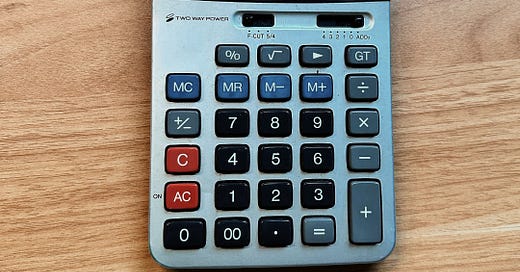Disclaimer: Yes, I am one of those people. In a world dominated by digital tools, AI assistants, and spreadsheets that can practically predict the future, I still swear by the trusty accounting calculator. It's not just a tool—it's an icon. So, let’s take a closer look at the unassuming hero of basic math, and uncover its understated magic. 🪄
🛠 The Problem It Solves: Math Without Meltdowns
Let’s face it: humans are wired to process shapes, colors, and TikTok videos—not numbers. Crunching numbers in your head or on a scrap of paper often ends in confusion or chaos.
Enter the accounting calculator. It takes the mental gymnastics out of everyday math. Whether you’re trying to calculate week-on-week growth (“Sales jumped from $43k to $56k—what’s the percentage increase?”) or dividing pizza slices with laser precision, it’s the low-tech superhero you didn’t know you needed.
🧑💻 Who Needs This? (Spoiler: More People Than You Think)
There are folks whose job demands quick, accurate calculations, yet whipping out a spreadsheet feels like bringing a bazooka to a water balloon fight.
The Secretary: Juggling budgets across departments while fielding a dozen other questions from the boss.
The Agent: Calculating commissions and fees for clients in real-time—accuracy is non-negotiable.
The Bakery Chef: Scaling recipes to match customer orders without accidentally doubling the sugar.
What these people share is a need for effortless accuracy. A tool that’s always there, works instantly, and doesn’t judge you for forgetting how to calculate percentages. Plus, no pesky “low battery” warnings.
🎯 Why It Wins: Focused and Flawless
The accounting calculator has one job—and it absolutely nails it. Every time you see a result flash on its monochrome LCD, it’s a small but satisfying aha! moment.
No tutorials, no apps, no “accept our new terms and conditions” pop-ups. Just:
Push the button.
Get the number.
Move on with your life.
80% of the buttons handle daily tasks (hello, +, -, %, and the satisfyingly chunky “C”). The other 20% — those cryptic memory buttons like MC, MR, M+, and M-—are more like your insurance policy: rarely used but life-saving when you need them.
Even the less obvious ones (looking at you, √ and GT) have their moments of glory, perhaps once a year? 🙃
📱 Calculator Apps Can’t Kill This Dinosaur
The most obvious competition for accounting calculators is the calculator app on your smartphone. It’s there. It’s free. It’s convenient.
But let’s be honest: it has some flaws.
Battery Dependency: When your phone is dead, so is your math game.
Extra Clicks: Getting to the app involves more steps than you’d think.
Button Deficiency: No MC, MR, or M+ on most apps (how are we living like this?).
❗The worst - Notifications: Nothing ruins a perfectly good calculation like your phone pinging with, “You up?”
Meanwhile, the accounting calculator is laser-focused. No distractions, no surprises, just numbers. It doesn’t care about your DMs or your latest Candy Crush score.
🔮 The AI Threat: Friend or Foe?
Now, let’s talk about the elephant in the room: AI.
These days, I can ask Siri, “What’s 2:5 water-to-flour for 300g of dough?” and get a decent answer (eventually). It’s not perfect yet, but we all know how fast tech evolves. So where does that leave our humble calculator?
Opportunity knocks. The accounting calculator can rebrand as the tool for focus. In a world buzzing with digital distractions, it’s a retro antidote. A simple, reliable way to get your numbers right while keeping your head in the game.
Final Thoughts
The accounting calculator isn’t trying to replace your spreadsheets or AI. It’s not pretending to be “smart.” What it offers is simplicity, speed, and peace of mind. So, here’s to the quiet workhorse of math—the gadget that does its job so well, you almost forget it’s there.
Keep one on your desk. You’ll thank me the next time your phone dies mid-equation.




